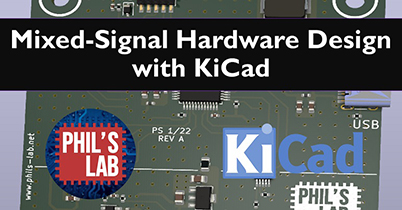Benefits of our courses
Money-back
guarantee
guarantee
If, within 30 days of placing your order, you discover that our courses do not meet your expectations, you will receive a full refund.
Experienced
instructors
instructors
Our instructors are highly experienced professionals and recognized authorities in the technical world.
Course
certificate
certificate
You will receive a course certificate upon completing coursework and finishing the course.
Practical
information
information
Our instructors share their knowledge and experience with you to make your learning process easier.
What you will learn in this course
1
Starting a new project
How to effectively manage your own symbol and footprint libraries in KiCad? We’ll explore how to create, organize, and maintain libraries to streamline your PCB design process. Setting up symbol and footprint libraries in KiCad. Creating and organizing custom libraries for your projects. Adding new components to your libraries, including symbols for resistors, capacitors, and integrated circuits. Editing and updating existing library components.
2
Symbol and Footprint Creation
In this chapter, you’ll master the art of creating and customizing both symbols and footprints in KiCad, enabling you to tailor components precisely to your project’s needs. You’ll learn how to design custom symbols and footprints from scratch, reuse and modify elements from KiCad’s default libraries, and integrate custom 3D models for a complete and professional design.
3
Schematic capture
The simplest and most effective method for creating schematics in KiCad using the custom symbols you’ve created. The project focuses on designing a switching buck converter circuit based on the LMR50410 IC. Placing custom symbols into the schematic and organizing the layout. Drawing connections between components, including power nets and signal paths. Proper use of nets, labels, and annotations for a clear and professional schematic.
4
Component placement and PCB Shape Design
Moving from schematic design to PCB layout by focusing on component placement and defining the PCB shape. You’ll learn how to organize your components efficiently while creating a professional and functional board outline. Importing your schematic into the PCB Editor and transferring components. Strategically placing components to optimize layout, signal flow, and manufacturability.
5
PCB Layout
Bring your design to life by creating the PCB layout. We’ll cover everything from routing tracks and defining copper polygons to customizing the silkscreen layer and adding your own logo for a professional touch. Routing tracks between components, ensuring clean and effective signal paths. Using copper polygons to define power planes and ground planes for improved performance. Managing clearances and layer stacking to meet design and manufacturing requirements.
6
Manufacturing Data Export
Learn how to prepare and export all the necessary data for manufacturing and assembly of your PCB. From generating Gerber files to creating assembly drawings and a detailed Bill of Materials (BOM), this chapter ensures your design is production-ready. Exporting Gerber files for PCB fabrication, including copper layers, silkscreen, solder mask, and drill files. Generating component placement data (Pick-and-Place files) for automated assembly processes. Creating assembly drawings to guide the manufacturing team, including clear visualizations of component positions. Exporting a comprehensive Bill of Materials (BOM) with all component details for ordering and assembly.
7
Prototype Testing and Final Remarks
In this final chapter, you’ll see how I tested the manufactured prototype to ensure it functions as intended. We’ll cover practical testing techniques, including using resistive loads and performing tests without a load, to validate your design under different conditions.
Pricing Plans
Choose from three different pricing plans that meet your needs and expectations. Begin your learning journey today.
Online
$57
- Ideal for Students & Hobbyists
- Online video access for 12 weeks for 1 person
- Every online access can be extended for free for 1 month
- All lessons available immediately
- PDF Certificate (after completing activities) for 1 person
- 100% money-back guarantee (up to 30 days from order)
- Unlimited video access (once downloaded)
- Video download available
RECOMMENDED
Online and Download
$115
- Ideal for everyone who wants lifetime access
- Online video access for 12 weeks for 1 person
- Every online access can be extended for free for 2 months
- All lessons available immediately
- PDF Certificate (after completing activities) for 1 person
- 100% money-back guarantee (up to 30 days from order)
- Unlimited video access (once downloaded)
- Video download available after 30 days
Quick Download
$174
- Ideal for Professionals and Companies requiring 3 licenses
- Online video access for 12 weeks for up to 3 people
- Every online access can be extended for free for 3 months
- All lessons available immediately
- PDF Certificate (after completing activities) for up to 3 people
- 100% money-back guarantee (up to 30 days from order)
- Unlimited video access (once downloaded)
- Video download available immediately
Frequently asked questions about the course
Related Courses

FROM$139
Advanced Digital Hardware Design
Learn how to design your own advanced hardware featuring FPGAs/SoCs/CPUs, high-speed memory and peripherals.

FROM$117
Mixed-Signal Hardware Design with KiCad
In this course, you'll learn how to design a complete, embedded, mixed-signal product from scratch - all the w...

FROM$80
KiCad for Makers
This hands-on video course takes you step by step through the complete process of designing, building, and tes...